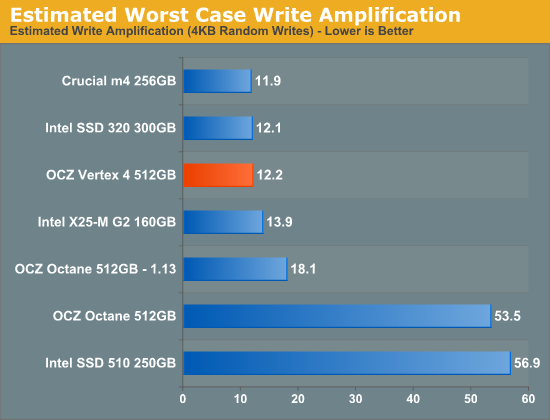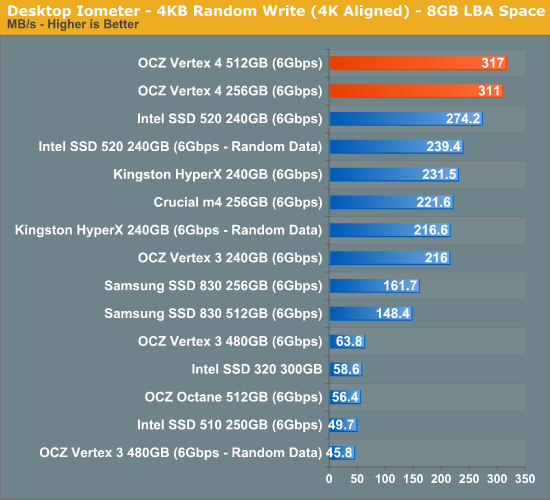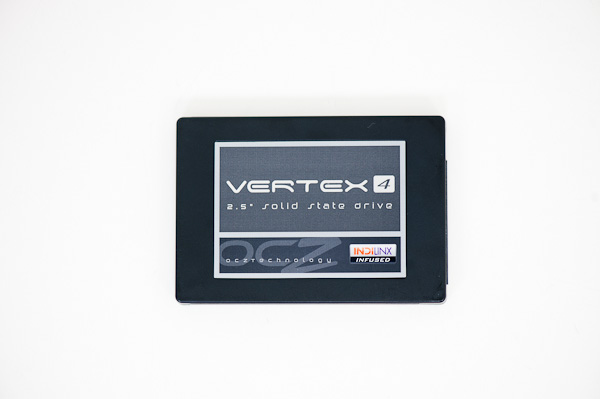OCZ Vertex 4 Review (256GB, 512GB)
by Anand Lal Shimpi on April 4, 2012 9:00 AM ESTThirteen months ago OCZ announced its intention to acquire Indilinx, the SSD controller maker that gave Intel its first taste of competition in the consumer market in 2009. Eight months later, OCZ launched its first post-acquisition SSD based on Indilinx silicon. Today, just five months after the launch of the Octane, OCZ is officially releasing the Vertex 4 – based on its Indilinx Everest 2 silicon. In less than a year, OCZ has brought to market more Indilinx powered controllers than Indilinx did in the previous three years. It's rare that you see the fruits of acquisition so quickly, but if there's anything OCZ's CEO Ryan Petersen is good at it's pushing for an aggressive schedule.
Rather than call this drive the Octane 2, OCZ went with Vertex 4, indicating its rightful place at the top of OCZ's SSD lineup. The implications run even deeper. It marks the first time in two years that a Vertex drive will ship without a SandForce controller inside. Make no mistake, while Octane was a shot across SandForce's bow, Vertex 4 means war. While OCZ continues to ship tons of SandForce controllers, the future for the company is Indilinx. The Vertex 4 is just the beginning. OCZ will continue to ship Vertex 3 in parallel, and should a future SandForce controller make competitive sense to use OCZ will definitely consider it, but the intention is to build the fastest silicon internally and use it as much as possible.
The dramatic departure in naming also embodies just how different Everest 2 is from the original Everest controller. OCZ claims there's minimal shared code between the Octane and Vertex 4 firmware, and the two drives perform very differently. Write amplification was always a concern with the Octane - it is no longer a major issue with the Vertex 4. OCZ and its Indilinx team have reduced write amplification to roughly the levels of Intel's controllers:

Indeed write performance is improved significantly as a result. A look at the spec sheet gives us the first indication of what's to come:
| OCZ SSD Comparison | ||||||
| OCZ Vertex 4 | OCZ Vertex 3 | OCZ Octane | OCZ Vertex 2 | |||
| Current NAND | 25nm IMFT MLC | 25nm IMFT MLC | 25nm IMFT MLC | 25nm IMFT MLC | ||
| Capacities | 128, 256, 512GB | 60, 90, 120, 240, 480GB | 128, 256, 512GB, 1TB | 60, 120, 240GB | ||
| Controller | Indilinx Everest 2 | SF-2281 | Indilinx Everest | SF-1221 | ||
| Max Seq Read | 535 MB/s | 550 MB/s | 480 MB/s | 285 MB/s | ||
| Max Seq Write | 475 MB/s | 500 MB/s | 330 MB/s | 275 MB/s | ||
| Max Random Read | 95K IOPS | 60K IOPS | 26K IOPS | - | ||
| Max Random Write | 85K IOPS | 85K IOPS | 35K IOPS | 50K IOPS | ||
| AES-256 Encryption | Yes | Yes | Yes | No | ||
Regardless of the nature of the data (compressible or incompressible), the Everest 2 powered Vertex 4 promises better random write performance than any other consumer SSD on the market today. And it delivers:

Random write speed is nothing short of incredible. OCZ is able to equal SandForce's write speed on highly compressible data without resorting to any sort of data compression. This is a purely algorithmic advantage. While the original Everest was a work in progress by the time OCZ acquired the company, Everest 2 is the first Indilinx project OCZ had complete control over. Apparently OCZ's CEO, Ryan Petersen had a lot of his own input built into this design.
| OCZ Vertex 4 Lineup | |||||
| 512GB | 256GB | 128GB | |||
| NAND Configuration | 16 x 32GB 25nm Intel sync NAND | 16 x 16GB 25nm Intel sync NAND | 8 x 16GB 25nm Intel sync NAND | ||
| DRAM | 2 x 512MB DDR3-800 | 2 x 512MB DDR3-800* |
2 x 512MB DDR3-800* | ||
| Controller | Indilinx Everest 2 | Indilinx Everest 2 | Indilinx Everest 2 | ||
| Max Seq Read | 535 MB/s | 535 MB/s | 535 MB/s | ||
| Max Seq Write | 475 MB/s | 380 MB/s | 200 MB/s | ||
| Max Random Read | 95K IOPS | 90K IOPS | 90K IOPS | ||
| Max Random Write | 85K IOPS | 85K IOPS | 85K IOPS | ||
| MSRP | $699 | $349 | $179 | ||
The Vertex 4 will be available in three capacities initially – 128GB, 256GB and 512GB, with a 1TB version following. Drives should be available today but in very limited quantities, and likely only 128GB capacities at the start. MSRP is fairly competitive with other 6Gbps drives on the market today:
| SSD Pricing Comparison | |||||
| 128GB | 256GB | 512GB | |||
| Crucial m4 | $154.99 | $299.99 | $549.99 | ||
| Intel SSD 520 | $184.99 | $344.99 | $799.99 | ||
| Samsung SSD 830 | $174.99 | $299.99 | $779.99 | ||
| OCZ Octane | $199.99 | $339.99 | $849.99 | ||
| OCZ Vertex 3 | $199.99 | $339.99 | $1199.99 | ||
| OCZ Vertex 4 | $179 MSRP | $349 MSRP | $699 MSRP | ||











127 Comments
View All Comments
ViviTheMage - Wednesday, April 4, 2012 - link
mmmmmm, iops.LB-ID - Wednesday, April 4, 2012 - link
It's still a drive from OCZ, a company that has repeatedly and blatantly used its customer base as unpaid beta testers, and lambasted them when they dared to complain about it. No thank you. The fastest drive in the world is of no use to me if it's causing my computer to BSOD constantly. I'll be spending my money and that of my many clients on drives with proven track records for reliability and excellent customer service, both sadly lacking in OCZ products.hackztor - Wednesday, April 4, 2012 - link
Ocz is the only one that actually got to the bottom of the bsod screen on sandforce. In the end it was sandforce fault because they made the controller. All the other companies waited and then used the fix. Intel is the exception who waited a whole year before releasing them to validate but they still use sandforce controllers. Vertex4 is the 1st time that ocz now owns the controller and firmware that goes into the product. I hope this will prove to be better and have quicker fixes. Ocz is always the first to release the technology so expect some issues, but thats what people take for early adopting. I had 5 vertex 1 die on me and then they upgraded me to a vertex2. Just purchased the 4 so hope all goes well.taltamir - Wednesday, April 4, 2012 - link
"Ocz is the only one that actually got to the bottom of the bsod screen on sandforce."Actually that was intel.
hackztor - Wednesday, April 4, 2012 - link
Not true. Ocz pushed sandforce to finally find the issue based on what the users were telling ocz while sandforce kept trying to deny the issue and could not find it in a lab environment. If you see further down I said intel waited a year with validation going on.breakSSD - Thursday, April 5, 2012 - link
You have no idea about ssd validation if you think Ocz pushed sandforce for BSOD.The fact is that Intel found this and kept sandforce busy with fixing the issue while ocz even though knowing the issue release agility 3. Anyways doesn't matter who takes the credit, people know where to go when it comes to reliability.iceman98343 - Friday, April 6, 2012 - link
you do realize intel 520s are now getting bsods?!Obsoleet - Saturday, April 7, 2012 - link
You go to Samsung for reliability. Iceman is correct, word is spreading of more 520 stability issues. If you want the fastest, most reliable SSD get the 830 as Anand recommends.Einy0 - Saturday, April 7, 2012 - link
At work we have deployed about 50 - 80GB Intel 320 Series Drives and so far nearly 60 - 64GB Samsung 830 Drives. The Samsung drives are screamers but we've seen a lot of strange issues with the Samsung drives that we never had with the Intel drives. We have not had a single drive from either company fail or come DOA. That amazes me personally, not a single dud. We've literally had dozens of faculty members come ask us what we did to their computer that made it so fast all of a sudden. The issues we've had with the Samsung drives about 1 in 10 causes Windows mini-setup to freeze. We re-image the drive again it works just fine. We are thinking maybe the compatibility with some SATA controllers isn't as robust on the Samsung drives as it is on the Intel drives.gandx - Tuesday, April 24, 2012 - link
Or choose a SSD with a marvell controller like the Corsair Performance Pro or Plextor M3P. Both are fast and stable. I would never choose a SSD with sandforce again after using a vertex 3 for a while with lot or problems and i'm obviously not the only one.